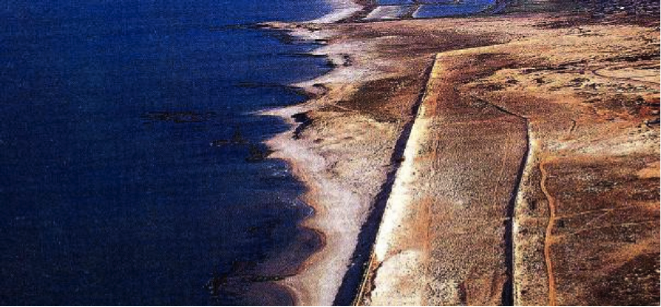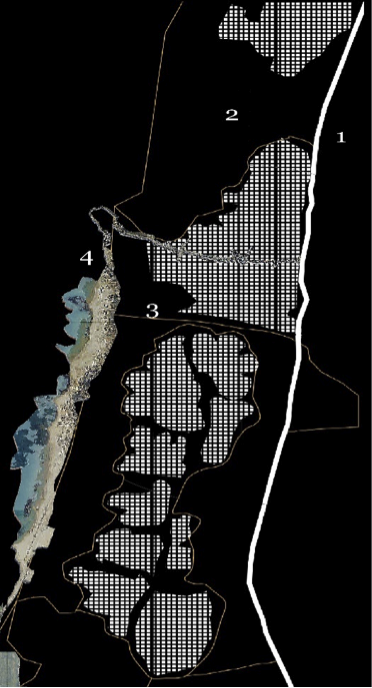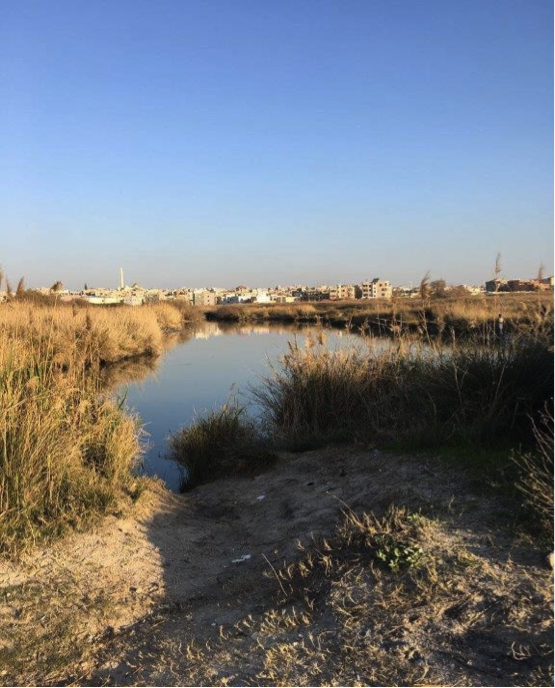
Archipelago against the Mediterranean Sea: The fragmented Israeli northern coastal strip
Nilly R. Harag, Ziv Leibu
Traveling along Israel’s coastal highway may mislead the eye. Distracted by the pastoral sceneries along the seashore, one can override the cultural landscape and conflicting historical narratives characterized by fragmentation, polarity and multiplicity. This phenomenon is epitomized in a narrow strip confined by the sea and the highway, midway between Tel- Aviv and Haifa. One of the most prominent sites in the strip inhabits three diverse entities encircled by Archaeological relics, natural reserves, roads and mediating areas. These culturally and morphologically contrasted entities are: Kibbutz Ma’agan Michael, suburban Caesarea, and the Arab town of Jisr a-Zarqa situated in between. Through the exploration of the site we intend to question the phenomena of a contested Arab town, envisioned as a growing island with potential for social explosion.[1]
Historical analysis sheds some light on the evolution of the fragmentation in this site. Jisr a-Zarqa was established in the 19th century, when two main Bedouin tribes settled in the area adjacent to the swamps of Kabara. The site of settlement, however, was not vacant but encircled by archaeological remains such as those of ancient Caesarea, its Roman water infrastructure, and the Hellenistic relics along the Crocodile River to the north of the village. These remains, alongside modern development carried out by the Israeli state, served as a spatial platform in the fulfilment of national goals.
During the British Mandate for Palestine, the Zionist authority consolidated a spatial strategy focused on settlement continuity on the coastal strip. The sporadic development was carried out through a reinforcement of cities, and through re-establishing old and new settlements, kibbutzim, highways, and industry. Following the establishment of the Israeli state, the governmental planning department had set up a national outline plan which aspired to disperse the development through towns, settlements, and infrastructures. The planning department also defined a network of national parks; nature reserves integrating the preservation of archeological sites to these new landscapes. The urge was to dig, excavate, plant and redesign, in order to shape the national identity and mold it into the space, all the while eliminating the remains of the dispersed Palestinian inhabitation.[2]
Juxtaposing critical mapping and historical analysis identifies a spatial apparatus imposed on the site to mediate political and socio-economical ideologies. National parks, preserved beaches, archeological sites, tourist attractions and highways, all serve today as objects of visibility and separation. This investigation focuses on three main spaces as spatial realities via which an Archipelago of new liminal reality, is being created: The coastal highway, the Crocodile River natural reserve, and the rampart.
 |
|
| (a) Aerial view of Kibbutz Ma’agan Michael, modern Caesarea, and the Arab town of Jisr a-Zarqa in between. Source Google maps. | |
- The coastal highway: barrier as entrance
The Israeli coastal highway was built during the statehood period as one of the main modern traffic infrastructures connecting Tel-Aviv to the north of the country. However, while accelerating its users along the coast, the highway also contributes to a social stratification.[3] This phenomenon can be best exemplified in the highway’s location upon the dunes overlooking Jisr a-Zarqa. Despite this proximity there is no direct connectivity between the village and the highway. Situated under the highway, the village’s narrow entrance is the main route connecting its inhabitants to a distant bypass. Therefore, the village’s inhabitants who wish to travel north or south must drive many kilometers along this bypass, only to return to their departure spot: the highway. In addition to maintaining a distance, the highway serves as a border, restricting the village’s spatial growth to the agricultural fields at east. This point refers to the dual nature of the physical and the symbolic dimensions held by the highway, as it is both a barrier and an entrance. This threshold, therefore, is a well-defined line, sharply transforming the perception of the daily user moving between different entities, while reinforcing their contradiction.[4]
 |
| (b) A model – Jisr a-Zarqa as an island along the coastal highway. Anna Ivaleva |
- The Crocodile River natural reserve: State-ing historical landscape
As mentioned, the village of Jisr a-Zarqa is surrounded by various water sources and infrastructures: the remnants of the historic Kabara swamps, the Roman aqueduct, and the Mediterranean Sea to the west and south; Kibbutz’s Ma’agan Michael’s fishing ponds to the north; and the Crocodile River winding along and through the village. Throughout the centuries, the Crocodile River was known as the historic sea route, and these days this archaeological site consist of remains from the Hellenistic, Roman, and Byzantine periods. Following the settlement of the two original Bedouin tribes, the river also functioned as a water source used by the village’s inhabitants for private and agriculture purposes.
With the 1948 declaration of state of Israel, the Crocodile River, as other major landscape sites, was adjusted in accordance with the Zionist narrative. Archaeological sites had an extra incentive of “improving” sites while establishing historical ties to the holy land. When the Roman Caesarea archeological site became a national park, it instantly defined a larger area along the coastline to include the river route and the Aqueduct remains. These natural archeological findings enabled the new State of Israel to conserve the landscape, and preserve not only the site of Roman Caesarea, but also the horizon projected from it. When the national park was declared, an immediate elimination process occurred between Jisr’s dwellers and its Jewish settlement neighbors. With the new narrative projecting onto the site, Jisr dwellers found themselves both cut from their history, as well as prevented free access to a site that had served them for generations.
 |
| (e) The Aqueduct (part the Roman water infrastructure system) winding along the site.
Source Google images. |
- The rampart: in between artificial and organic
In 2003 the (modern) Caesarea development Company (CDC) began building an embankment, separating Caesarea’s southeastern neighborhood and Jisr a-Zarqa. A rampart, approximately one kilometer long and five meters high, was erected and planted, appearing as if it were part of the landscape, blurring the barrier’s purpose, and its naked barrier truth. This artificial barrier “grew” as a surprise to the resident of one side of the wall, while establishing a new segregating mechanism for the other side. The spatial contradiction between these two socio-political entities was reinforced and justified as an acoustic barrier, and as a physical division to prevent motor vehicles pass-by, while making it difficult for pedestrian strolling. This violent act took place despite previous negotiations between the two communities to design a park as an intermediate area. In an attempt to minimize the damage, Jisr a-Zarqa council suggested to keep a liminal[5] buffer zone of about 50 meters into Caesarea, or to lower the rampart’s height. Yet, instead, works continued, and soon appeared to become the actual reality.
On its Caesarean side, the leafy “natural” rampart is an artificial-picturesque backdrop, used as a tool to hide and therefore eliminate the other, different reality. Indeed, the fantasy of creating an organic, environmental-friendly, locally planted natural hill became a de facto segregating barrier. It functions as a billboard to Caesarea, while blocking the view and air to the neighboring village of Jisr a-Zarqa.
To conclude, despite the enforced geographical separation, a third reality is being produced by the two opposing realities. This distance, between the coastal highway, the Crocodile River, and the rampant, is the liminal reality, which can be apprehended only by occupying the gap between, to provide a new order to become the artificial connecting tissue.
A recent site visit revealed a new and sophisticated evolution carried out by an excavation process along the archeological relic sites of the Roman aqueduct, parallel to the rampart.[6] It seems that the act of division, eminent on the artificial surface, is undergoing a process of exposure of buried history. As a result of this process (stating the landscape), we assume that the coastal strip declared as a national reserve, might extend another arm to the southern district of the village. Consequently, a system of continuous reserves and national parks will by unified, while perpetuating the division and reinforcing the archipelago.
References:
Brutzkus Leonid, “Aims and Possibilities of Regional Planning,” Habinyan-a magazine ofarchitecture and town-planning August, 1938, 30-36.
Efrat Zvi, “Tavnit”, The Israeli Project: Building and Construction (Tel-Aviv Museum of Art, 2004) 992-1018
Gregotti, Vittorio, “The Form of the Territory” in: Oase Magazine: On Territories, issue 80, Tom Avermaete, Klaske Havik, Hans Teerds ed. (Netherlands 2009)
Handel Ariel. “Traffic”, in The Planners: directions in the Israeli planning discourse, ed Tali Hatuka and Tovi Fenster (Tel-Aviv: Resling, 2013) 249-260.
Lissovsky Nurit, “Spread you with rugs of gardens: Landscape Forms Identity”, in Arcadia: The gardens of Lipa Yahalom and Dan Zur, ed Nurit Lissovsky and Diana Dolev. (Tel Aviv: Babel, 2012) 81-97.
[1] This paper is based on historical sources and spatial analysis followed by Liminal Architecture Studio held at the Architecture Department, at the Bezalel Academy of Art and Design in Jerusalem 2016-17.
[2] Nurit Lissovsky, “Spread you with rugs of gardens: Landscape Forms Identity”, in Arcadia: The gardens of Lipa Yahalom and Dan Zur, ed Nurit Lissovsky and Diana Dolev. (Tel Aviv: Babel, 2012) 81-97.
[3] Ariel Handel. “Traffic”, in The Planners: directions in the Israeli planning discourse, Ed Tali Hatuka and Tovi Fenster (Tel-Aviv: Resling, 2013) 249-260.
[4] In the current Master Plan the highway is supposed to be diverted east to provide the extension of the village’s Borders, but it is doubtful due to the fact the highway is situated on the geological base of sand stone. Any extension will demand major foundation into the dunes. Thus, the barrier is visible and invisible onto the bedrock.
[5] Liminal: 1884, from Latin ‘limen’ as “threshold, cross-piece, sill”
(see limit (n.)) Great discovery! limit (v.) late 14c., from Old French limiter “mark (a boundary), restrict; specify,” from Latin limitare “to bound, limit, fix,” from limes “boundary, limit” (see limit (n.)). Related: limited; limiting.
limit (n.) c.1400, “boundary, frontier,” from Old French limite “a boundary,” from Latin limitem (nominative limes) “a boundary, limit, border, embankment between fields,” related to limen “threshold.” Originally of territory; general sense from early 15c. Colloquial sense of “the very extreme, The greatest degree imaginable” is from 1904
[6] A gated national park is in the process of being declared along the rampart, which will make present to the division.



